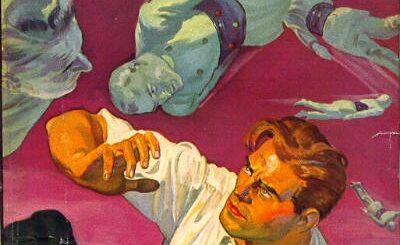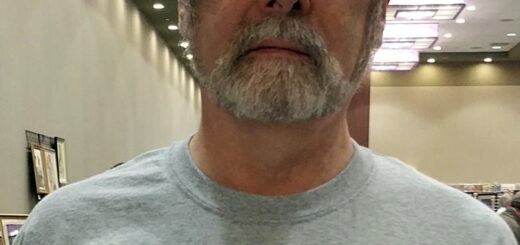Laurence Donovan
Laurence L. Donovan (July 1885 – March 11, 1948) was an American pulp fiction writer best known for writing nine Doc Savage novels.
Born in Cincinnati, Ohio, Donovan began his career as a press feeder in Covington, Kentucky, before turning to journalism. He worked as a copyreader and reporter for the San Francisco Call-Bulletin and the Vancouver Sun, and served as city editor for the Spokane Chronicle.
During the late 1920s, he transitioned into pulp fiction, contributing to a wide array of magazines—from the literary Argosy to the pulp Zeppelin Stories. According to family lore, Donovan was once considered for the screenplay of the 1925 silent epic Ben-Hur, but lost the opportunity during one of his infamous drinking binges. That same year, his vignette “The Old Copy Desk” appeared in The Saturday Evening Post.
In 1929 Donovan wrote “Brick Sacrifices” for Street & Smith’s Sport Story Magazine. By 1933, he was a regular contributor to various Street & Smith titles under editor John L. Nanovic, writing short stories for The Shadow, Doc Savage, Nick Carter, Pete Rice, and more. He occasionally used house pseudonyms such as Walter Wayne, and created original characters under pen names like Patrick Everett and Patrick Lawrence (combinations of his sons’ names.)
Donovan also wrote extensively for Movie Action, a short-lived Street & Smith title, where he adapted then-current screenplays into novelettes, including Tumbling Tumbleweeds, The Crime of Dr. Crespi, The Last Days of Pompeii, and Moonlight on the Prairie.
In 1935, Nanovic tapped Donovan to alternate with Doc Savage creator Lester Dent, producing nine novels under the Kenneth Robeson byline. He later leveraged his maritime experience to create Captain John Fury for The Skipper (as Wallace Brooker) and launched The Whisperer under the name Clifford Goodrich. After these titles folded during the recession of 1937–38, Donovan continued to write stories featuring these characters in the back pages of The Shadow and Doc Savage, and began ghostwriting Pete Rice stories in Wild West Weekly under the alias Austin Gridley.
His characters “Boxcar” Reilly and the postal inspectors Joe Bimbo and Howdy Hawks appeared in Crime Busters and The Feds, respectively. After a falling-out with Nanovic in 1938, Donovan joined the rival Thrilling Publications. There, he ghosted for The Phantom Detective under the house name Robert Wallace, introducing the character’s teenage sidekick, Chip Dorlan. He also contributed to most of Thrilling’s major series, including Dan Fowler, G-Man, The Masked Detective, and The Black Bat. One of his Black Bat novels, The Murder Prophet (1942), was a revised version of an unpublished Whisperer story titled The Crime Prophet.
Reliable information about Donovan’s life is scarce. Although he claimed Irish birth in County Cork, U.S. records show he was born in Ohio to Irish immigrant parents. While he consistently spelled his name “Laurence,” it may have originally been “Lawrence.” The Shadow author Walter B. Gibson recalled that Donovan had changed his surname from something like “Donegal.”
Donovan married Ruth Johnson in 1924. Their son, Laurence Jr., was born in 1927 in Vancouver, British Columbia; a second son, Patrick, followed a year later in Spokane, Washington. The family moved frequently, living in Flushing, Southampton (Long Island), Old Greenwich (Connecticut), and later Florida (St. Augustine and Fort Pierce). Donovan left Ruth in the late 1930s and later divorced her. A rumored earlier marriage produced a third son, though his name remains unknown.
A seasoned sailor, Donovan may have served in the Merchant Marine in his youth. He also wrote under additional pseudonyms, including Don Lewis, Don Lawrence, and Larry Dunn, which he used for racier fare in Spicy Detective Stories and its companion titles. His character John P. “Pa” Howdy appeared in Detective Fiction Weekly, Clues, and G-Men Detective over more than a decade. Other recurring characters included Joe Bunt (in Popular Detective) and Wildcat Martin (in both Popular Detective and Exciting Detective).
Laurence Donovan died in seclusion in Manhattan on March 11, 1948. His final known story, “Redheads Kill Easy,” was published posthumously in the February 1952 issue of New Detective.
Doc Savage, Vol. VI, No. 3, Murder Melody (Nov 1935) The sky over the Northwest is filled with strange floating men playing a weird melody of death.
Doc Savage, Vol. VI, No. 5, Murder Mirage (Jan 1936) A blizzard in July and a dead woman etched in glass lead Doc and crew to Saharan tombs guarded by Bedouins.
Doc Savage, Vol. VII, No. 2, The Men Who Smiled No More (Apr 1936) Even Doc Savage is stricken helpless by the terrifying menace of The Death’s Head Grin.
Doc Savage, Vol. VII, No. 4, The Haunted Ocean (Jun 1936) An awesome power haunts the sea, paralyzes New York City and brings the most powerful nations of the world to their knees.
Doc Savage, Vol. VII, No. 5, The Black Spot (Jul 1936) All the guests were dressed as gangsters but their millionaire host was dead in the library with a black spot over his heart.
Doc Savage, Vol. VIII, No. 1, Cold Death (Sep 1936) Doc Savage meets Var, who wields an unstoppable destructive ray: the deadly Cold Light.
Doc Savage, Vol. VIII, No. 5, Land of Long Juju (Jan 1937) The ruthless power of The Shimba threatened to overthrow the good and gentle ruler of an African kingdom.
Doc Savage, Vol. IX, No. 3, Mad Eyes (May 1937) In the space of twenty-four hours, the menace of the slithering madness struck in all its fury!
Doc Savage, Vol. IX, No. 5, He Could Stop the World (Jul 1937) The world was imperiled by a terrifying, malevolent force that had the power to change men’s minds.
— Text adapted from Wikipedia on Feb 4, 2018




Well, I hate to down anyone who ever had the honor of writing a Doc Savage tale, much less several of them, but for my money Donovan has to be the worst of the Doc ghost writers. His stories were always the most outlandish, silly, poorly plotted and written of the series. The characters are off, the villains just whack jobs and the plots usually goofy. He seems to throw out the usually grounded Doc Savage “world” where what appears to magic or monsters or outerspace weirdness is in fact just a ploy or some advanced science in action. He seemed to believe Doc Savage should be in fact weird wild magical and unrealistic in the extreme. Anything goes in his books. Wish it weren’t so, but his are the worst of the series.
Thomas Fortenberry
Donovan did contribute a few clunkers, I have to admit. But COLD DEATH and THE MEN WHO SMILED NO MORE are real gems. For my money, Bogart was the worst ghost, while, although producing a few worthwhile Docs,gave us the two worst: THE DEATH LADY and DEATH IN LITTLE HOUSES. Of all the contemporary ghosts, I found Donovan to be closest to Dent’s — though a little rougher.